SaaS tiered pricing is a strategic approach where software providers offer various subscription levels, each tailored with distinct features and pricing. This model not only enhances customer flexibility and scalability but also allows businesses to meet diverse needs and budgets, ultimately driving satisfaction and retention.

What is SaaS tiered pricing?
SaaS tiered pricing is a pricing strategy where software as a service (SaaS) providers offer multiple subscription levels, each with varying features and pricing. This model allows customers to choose a plan that best fits their needs and budget, promoting flexibility and scalability.
Definition of SaaS tiered pricing
SaaS tiered pricing refers to a structured pricing model that divides service offerings into different tiers or levels. Each tier typically includes a distinct set of features, usage limits, and support options, allowing customers to select a plan that aligns with their specific requirements.
This approach is beneficial for both providers and customers, as it enables businesses to cater to a diverse audience while allowing users to pay only for the features they need. Common tiers may include basic, standard, and premium options.
How tiered pricing works
Tiered pricing works by establishing multiple subscription levels, each with its own price point and feature set. For example, a basic tier might offer essential functionalities at a lower price, while higher tiers provide advanced features, increased usage limits, or priority support at a higher cost.
When implementing tiered pricing, businesses should consider factors such as customer needs, competitive pricing, and the value of additional features. It’s crucial to clearly communicate the differences between tiers to help customers make informed decisions.
Common pitfalls include overcomplicating the tier structure or failing to provide adequate value at each level. A simple, transparent pricing model often leads to better customer satisfaction and retention.

What are the benefits of SaaS tiered pricing?
SaaS tiered pricing offers multiple benefits, including cost savings for users and increased flexibility for businesses. By structuring pricing into different tiers, companies can cater to a variety of customer needs and budgets, enhancing overall satisfaction and retention.
Cost-effectiveness for users
Tiered pricing allows users to select a plan that aligns with their specific needs and budget, making it a cost-effective option. For instance, small businesses can opt for basic plans at lower price points, while larger enterprises can invest in more comprehensive packages that offer advanced features.
This model ensures that customers only pay for the services they actually use, which can lead to significant savings over time. Users can easily upgrade or downgrade their plans as their requirements change, providing financial flexibility.
Flexibility for businesses
For businesses, tiered pricing creates opportunities to attract a broader customer base by offering various plans that meet different needs. This flexibility can lead to increased market penetration and customer acquisition, as potential clients can find a suitable option without feeling overwhelmed by a one-size-fits-all approach.
Additionally, businesses can analyze customer behavior and preferences through tiered pricing data, allowing them to refine their offerings and marketing strategies. This adaptability can enhance customer loyalty and drive long-term growth.

How to structure SaaS tiered pricing?
Structuring SaaS tiered pricing involves creating multiple pricing levels that cater to different customer needs and budgets. Each tier typically offers varying features, usage limits, and support options, allowing customers to choose a plan that best fits their requirements.
Common pricing models
Common pricing models for SaaS tiered pricing include freemium, usage-based, and flat-rate pricing. Freemium models offer basic features for free while charging for premium features, appealing to a broad audience. Usage-based pricing charges customers based on their actual usage, which can be attractive for businesses with fluctuating needs.
Flat-rate pricing is straightforward, offering a single price for a set of features, making it easy for customers to understand costs. Hybrid models combine elements of these approaches, allowing for flexibility and customization based on customer segments.
Factors influencing pricing tiers
Several factors influence the creation of pricing tiers, including target market, competition, and feature differentiation. Understanding the target audience is crucial; different segments may value features differently, affecting how you structure your tiers. Competitor pricing can also guide your strategy, ensuring your offerings are competitive while still profitable.
Feature differentiation is key to justifying higher tiers. Offering advanced features, enhanced support, or additional integrations can make higher-priced tiers more appealing. Regularly reviewing customer feedback and usage data can help you refine your pricing structure to better meet market demands.
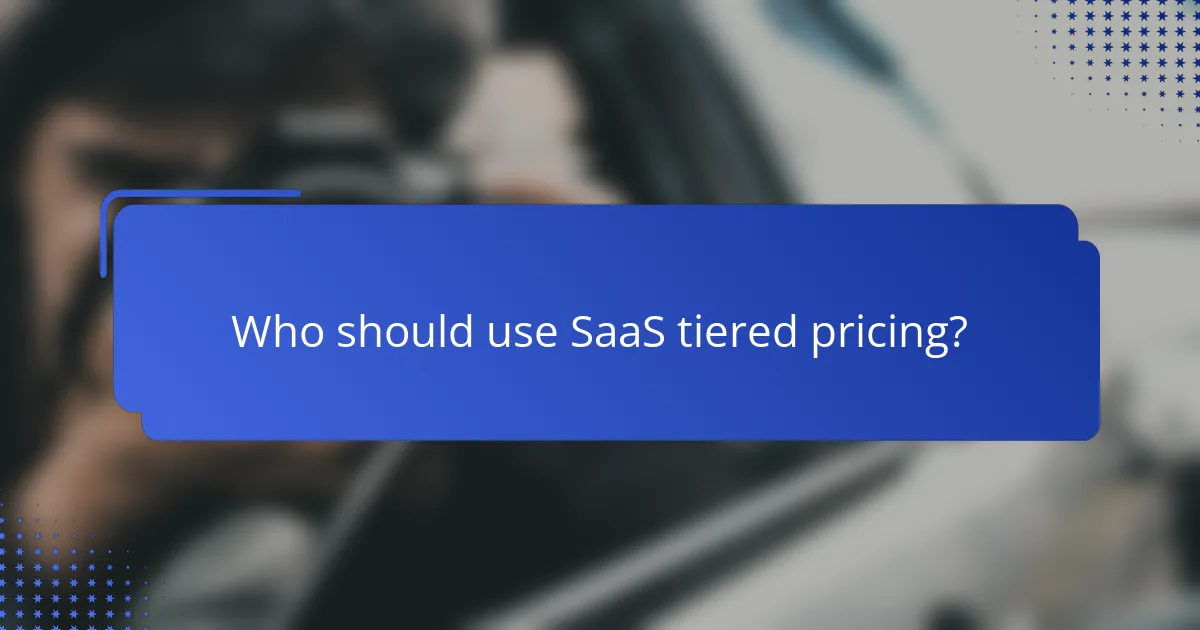
Who should use SaaS tiered pricing?
SaaS tiered pricing is suitable for businesses that want to cater to diverse customer needs while maximizing revenue. It allows companies to offer multiple pricing levels based on features, usage, or customer segments, making it ideal for various market conditions.
Ideal business types
Businesses that benefit most from tiered pricing typically include SaaS companies, subscription services, and digital platforms. Startups and small to medium enterprises (SMEs) can use tiered pricing to attract different customer segments by offering basic, standard, and premium plans.
For instance, a project management tool might offer a free tier for individuals, a mid-level plan for small teams, and an enterprise plan for larger organizations. This structure helps to accommodate varying budgets and feature requirements.
Market conditions for success
Successful implementation of tiered pricing often depends on competitive market conditions and customer willingness to pay. If the market has a range of similar offerings, tiered pricing can help differentiate a product by providing clear value at each level.
Additionally, businesses should consider customer feedback and usage patterns to refine their tiers. Regularly analyzing customer data can help identify which features are most valued, allowing for adjustments that enhance customer satisfaction and retention.
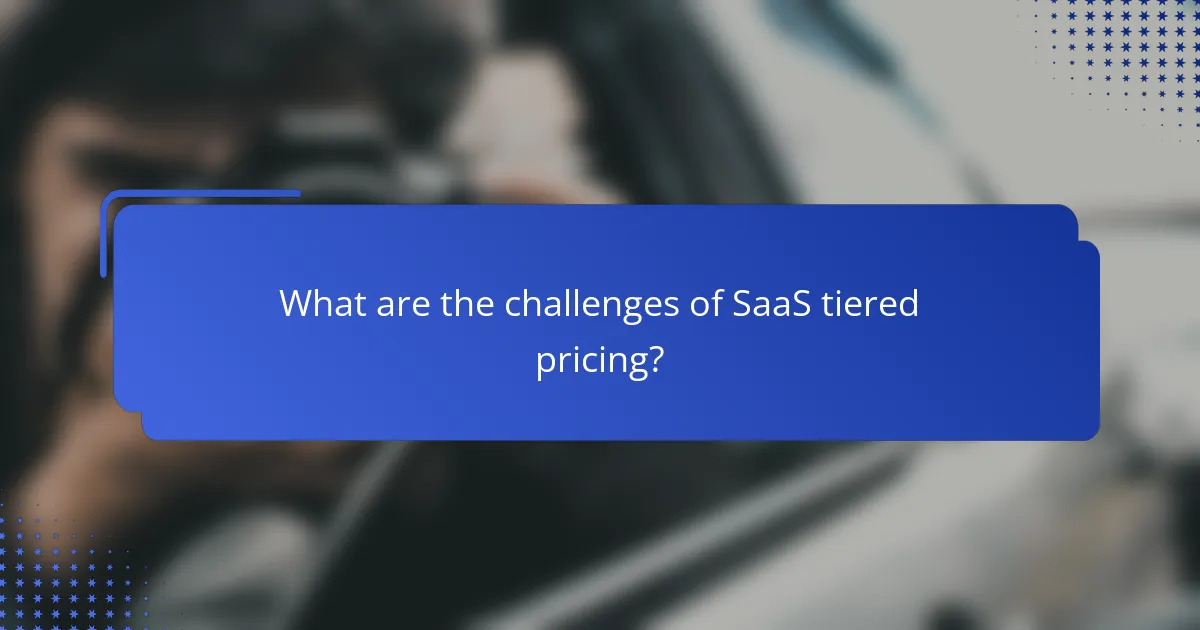
What are the challenges of SaaS tiered pricing?
SaaS tiered pricing can lead to several challenges, including customer confusion and potential pitfalls in pricing strategy. Understanding these issues is crucial for effectively implementing a tiered pricing model that meets both business and customer needs.
Customer confusion
Customers may struggle to understand the differences between pricing tiers, especially if the benefits and features are not clearly articulated. This confusion can lead to frustration and ultimately result in lost sales.
To mitigate this, provide clear comparisons of features across tiers, using simple language and visual aids like tables. Highlight the most significant differences to help customers make informed decisions.
Pricing strategy pitfalls
Choosing the wrong pricing structure can harm revenue and customer retention. Common pitfalls include overcomplicating the tiers or failing to align pricing with perceived value.
To avoid these issues, regularly review customer feedback and market trends. Consider implementing a limited number of tiers that clearly reflect the value offered, ensuring each tier meets distinct customer needs.
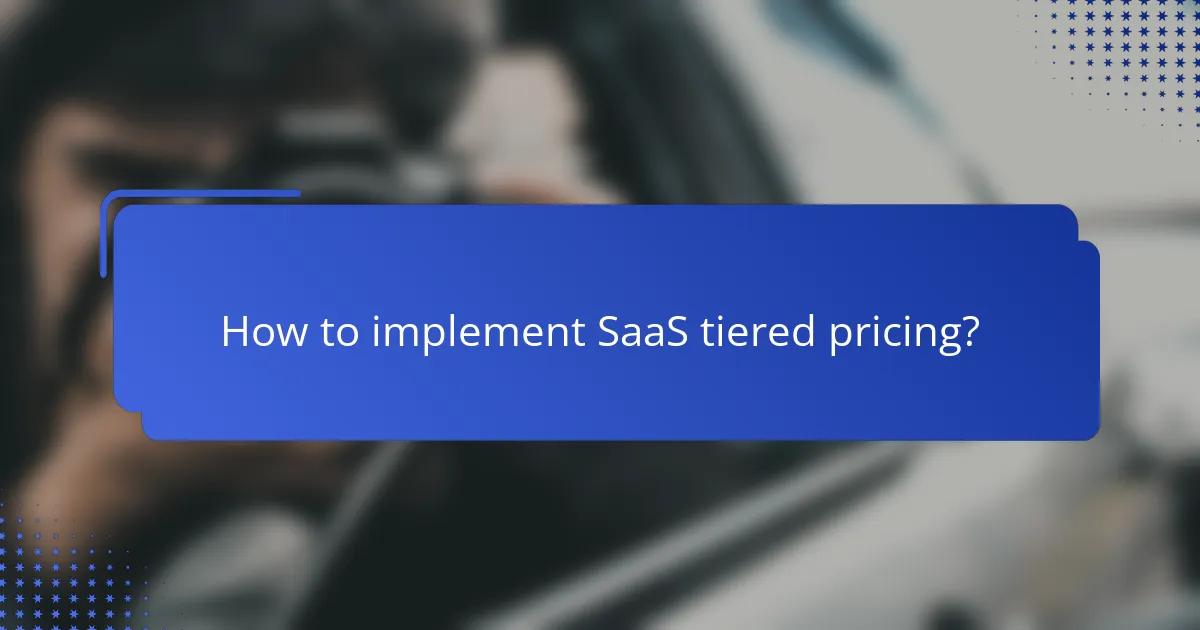
How to implement SaaS tiered pricing?
Implementing SaaS tiered pricing involves creating multiple pricing levels that cater to different customer needs and budgets. This strategy allows businesses to maximize revenue while providing options that can attract a wider audience.
Steps for implementation
Start by identifying your target customer segments and their specific needs. Conduct market research to understand what features are most valuable to different groups and how much they are willing to pay. Based on this information, define the tiers, ensuring each level offers distinct features or benefits.
Next, set clear pricing for each tier, considering factors like cost structure, competitor pricing, and perceived value. It’s essential to balance affordability with profitability, so aim for a price range that reflects the value provided while remaining competitive.
Finally, test your pricing model with a small group of customers or through A/B testing. Gather feedback and adjust the tiers and pricing as necessary to optimize conversion rates and customer satisfaction.
Tools for managing pricing
Utilize pricing management software to streamline the implementation and ongoing management of your tiered pricing structure. Tools like ProfitWell, Chargebee, or Stripe can help automate billing, track customer usage, and analyze pricing performance.
Additionally, consider using analytics tools to monitor customer behavior and preferences. This data can inform adjustments to your pricing tiers and help identify which features drive the most value for different segments.
Regularly review your pricing strategy to ensure it remains aligned with market trends and customer expectations. Staying flexible and responsive to feedback will enhance your ability to retain customers and grow revenue over time.
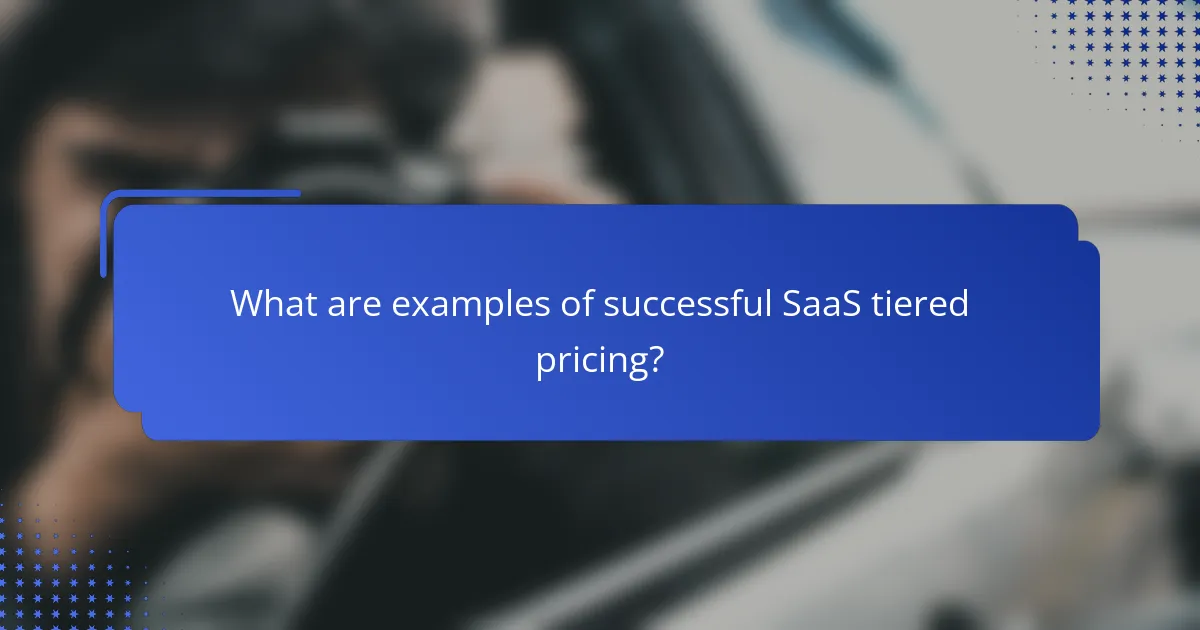
What are examples of successful SaaS tiered pricing?
Successful SaaS tiered pricing models allow companies to cater to different customer needs and budgets, maximizing revenue while providing flexibility. Notable examples include Shopify and Slack, each employing distinct strategies to appeal to various market segments.
Shopify pricing tiers
Shopify offers several pricing tiers designed for different business sizes and needs. Their plans typically range from basic options for startups to advanced features for larger enterprises, with monthly fees varying from around $29 to $299, depending on the selected tier.
Each tier includes specific features such as online store capabilities, payment processing, and customer support. Businesses should evaluate their requirements against the features offered in each tier to choose the most cost-effective option.
Slack pricing structure
Slack’s pricing structure consists of a free tier and several paid plans that cater to different organizational sizes and collaboration needs. Paid plans start at approximately $6.67 per user per month and can go up to around $12.50 per user per month, offering enhanced features like increased storage and advanced security options.
When selecting a plan, organizations should consider factors such as team size, necessary integrations, and required compliance features. It’s crucial to assess whether the additional features justify the cost for your specific use case.
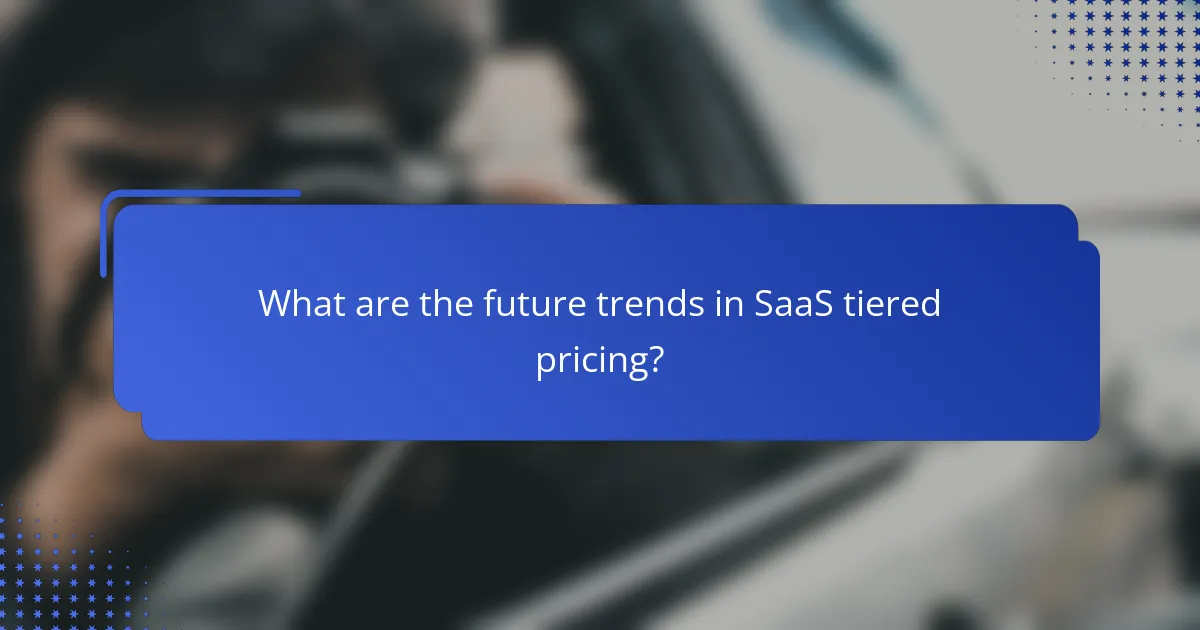
What are the future trends in SaaS tiered pricing?
Future trends in SaaS tiered pricing are leaning towards more personalized pricing models and increased flexibility. Companies are focusing on customer-centric approaches, allowing users to tailor their subscriptions based on specific needs and usage patterns.
Personalization and Customization
Personalization in SaaS tiered pricing involves creating plans that cater to individual user requirements. This may include customizable features, usage limits, and pricing based on actual consumption rather than predefined tiers. For example, a software provider might offer a base plan with essential features and allow users to add functionalities as needed.
Customization can enhance user satisfaction and retention by ensuring that customers only pay for what they use. Companies should consider implementing tools that allow users to easily adjust their plans based on changing needs.
Usage-Based Pricing Models
Usage-based pricing models are gaining traction as they align costs with actual usage. Instead of a flat monthly fee, customers pay according to the resources they consume, such as API calls or storage space. This model can be particularly appealing for startups and small businesses that may have fluctuating needs.
Implementing a usage-based model requires robust tracking and reporting tools to ensure transparency and accuracy in billing. Companies should clearly communicate how usage is measured and billed to avoid confusion and dissatisfaction among users.
Integration of AI and Automation
Artificial intelligence (AI) and automation are increasingly being integrated into SaaS pricing strategies. These technologies can analyze user behavior and preferences to suggest optimal pricing tiers or features. For instance, AI could identify when a user is nearing their usage limit and prompt them to upgrade to a higher tier.
Automation can streamline the pricing process, making it easier for customers to adjust their plans without manual intervention. Companies should invest in AI-driven analytics to enhance their pricing strategies and improve customer experiences.
Focus on Value-Based Pricing
Value-based pricing is becoming a key trend, where prices are set based on the perceived value to the customer rather than solely on costs. This approach requires a deep understanding of customer needs and the unique benefits the software provides. For example, a SaaS product that significantly improves productivity may justify a higher price point.
To implement value-based pricing effectively, companies should gather feedback from users and conduct market research to assess how much customers are willing to pay for specific features. This strategy can lead to increased revenue and customer loyalty when executed correctly.
